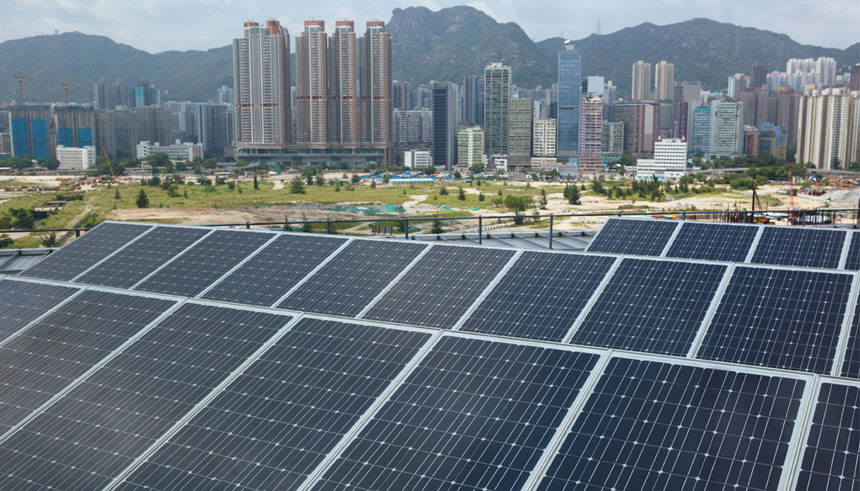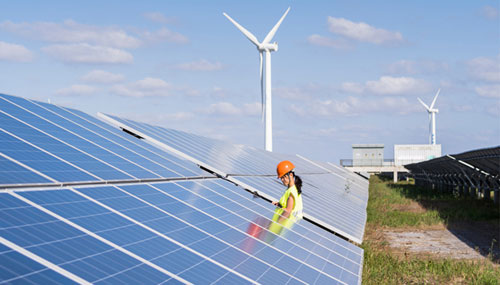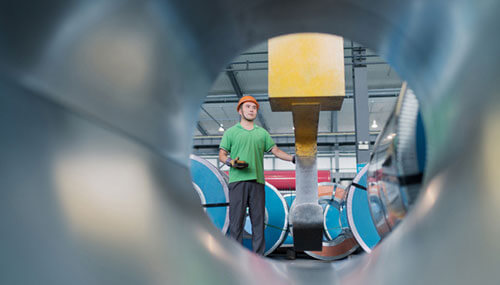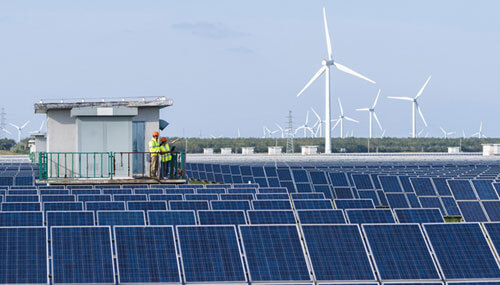U.S.-Asia Business
China’s Solar Surge Presents Future Opportunity
By Daniel Allen

New investment and targets open up markets in power generation and panel manufacturing.
China is currently the world's largest carbon emitter, burning more coal than any other nation. Yet thanks to the ongoing rollout of a highly ambitious renewable energy plan, the country's emissions may already be on the verge of peaking.
Under the terms of the 2015 Paris Agreement, China pledged its greenhouse gas emissions would peak around 2030. Driven by this commitment – and a pressing need to curb the smog and pollution that blight many Chinese cities – Beijing is now investing huge sums in clean energy. With Chinese coal consumption dropping nearly four percent in 2015, this already appears to be paying off.
Much of this clean energy investment has been in solar power. According to the latest statistics from China’s National Energy Administration, China added more than 15 gigawatts of new solar capacity in 2015 (a year-on-year increase of 74 percent), surpassing Germany as the world's largest solar power market. The country now boasts 43.2 GW of solar capacity, compared with 38.4 GW in Germany and 27.8 GW in the United States.
This solar surge shows no sign of abating. Under the terms of the country's Thirteenth Five-Year Plan (2016-2020), Beijing wants to more than triple installed solar power capacity to more than 140 GW by 2020. Solar industry analysts believe this figure is highly attainable.
"With the market continuing on its current trajectory, we expect China will continue to install around 20 GW annually through 2020," says Mohit Anand, a senior analyst covering global solar markets with advisory firm GTM Research, which has offices in Boston, New York and San Francisco.
Solar skew
With huge expanses of desert land, China has abundant potential solar energy resources. "The annual solar energy received by China's terrestrial surface is estimated to equal the energy resources of 4.9 trillion tons of standard coal, or more than the total electricity output of 10,000 dams the size of the Three Gorges facility," explains Jennifer Rigney, senior director of corporate communications at BrightSource Energy Inc., an Oakland, Calif.-based, utility-scale solar power plant company.
According to the China National Renewable Energy Centre, provinces in the north and west of China – such as Qinghai, Inner Mongolia, Gansu and Xinjiang – offer the most potential for generating solar power. Not surprisingly, this is where most of the country's utility-scale solar power plants have so far been constructed.
China's climatology may be good for solar power generation in overall terms, but the skewed concentration of its generating facilities in geographically remote regions throws up significant problems.
With energy consumption on China's heavily urbanized east coast far higher than consumption in its western hinterland, curtailment (essentially energy wastage arising because of a shortage of transmission capacity) is already an issue. According to Chinese government figures, nearly 10 percent of China's solar output was curtailed in the first half of 2015, compared with negligible curtailment rates in countries such as the United States and Germany.

"We expect China will continue to install around 20 GW annually through 2020. "
Distribution drive
While the scaling up of its national power grid is undoubtedly important, China can also slash curtailment levels by boosting distributed energy generation – generating power on a smaller scale far closer to end users, thereby reducing the need for long-distance transmission. During the past few years, Beijing has set lofty targets for distributed solar energy, underpinned by subsidies to encourage people and businesses to install photovoltaic panel arrays (mostly on roofs).
But despite these moves, progress has so far been disappointing. According to China's National Energy Administration, the total capacity of distributed PV projects accounted for just 14 percent of China's total solar energy-generating capacity at the end of last year. Reasons for this slow growth include poor financing options for small-scale projects, myriad regulatory obstacles, a lack of suitable space for installing panels and property rights conflicts between developers and rooftop owners.
"There are still too many uncertainties and players involved in the development of distributed PV installations," says Grace Zhang, chief solar analyst at Guangzhou-based market research firm CCM. "Beijing wants distributed solar energy to account for 50 percent of the total solar energy generated in China in 2020. Fixing these issues quickly and effectively is therefore essential."
Beijing will continue to use financial incentives to accelerate the shift toward distributed solar. This year has seen cuts to feed-in tariffs – energy subsidies offered to both utility-scale and distributed solar energy generators from 2011 onward – by China's National Development and Reform Commission. By making the sharpest subsidy cuts in the western regions of China, the NDRC hopes to encourage the development of distributed and off-grid solar power projects in eastern provinces.
"Beijing wants distributed solar energy to account for 50 percent of the total solar energy generated in China in 2020."

The rise of Concentrated Solar Power (CSP)
China's burgeoning involvement with photovoltaic power – both in terms of panel manufacturing and domestic power generation – has been well documented. But the country is now witnessing the development of a new solar frontier.
China's Thirteenth Five-Year Plan sets a capacity target of 10 GW for concentrated solar power facilities by 2020. In contrast with PV panel arrays, where there are no moving parts, concentrated solar power facilities use giant mirrors or lenses to concentrate a large amount of sunlight onto a tower, generating enough heat to turn water into steam and drive a turbine – just as in a conventional power station.
One big advantage of CSP systems over their PV counterparts is their greater flexibility in generating and supplying electricity. Newer CSP plants, which use molten salts to store heat, can produce electricity for several days, even if there is no sun. This means that they can deliver power as and when it is needed – much in the same way that conventional baseload power operates.
Although CSP systems have traditionally been regarded as more expensive than PV systems, the costs are now coming down. If China fulfills its commitment to develop 10 GW of CSP capacity by 2020, it will become a global leader in CSP technology, since global installed CSP capacity currently stands at around 5 GW.
During the next few years, significant Chinese investment is likely to decrease the costs of components and systems even further, as experimental technologies become commercialized. In turn, this should make CSP systems increasingly affordable on an international scale.
"China's investment in CSP will benefit the industry by further reducing the LCOE (levelized cost of electricity), de-risking the technology through deployment and advancing new CSP technologies," says BrightSource Energy's Rigney.
Collaborative commerce
Going forward, almost all of China's new solar-energy-generating capacity is likely to be manufactured and installed by Chinese companies. Yet these companies are still dependent on imports for several key materials and technologies, especially when it comes to leading-edge projects.
According to a recent report from CCM, such materials include silver paste, TPT backsheets, EVA encapsulant film and high-purity polysilicon, all used in panel manufacture. There are also opportunities for international companies to provide engineering, procurement and construction services.
"Several Western technology providers have already formed partnerships in China to participate in commercial-scale pilot projects," says Tian Tian, international energy analyst at the National Renewable Energy Laboratory in Golden, Colo.
In November 2014, BrightSource Energy formed a joint venture with Shanghai Electric Group to build CSP plants in China. The Huanghe Qinghai Delingha Solar Thermal Power Project in Qinghai province is under construction and will become one of the first commercial CSP pilot projects in China. If and when the project is fully realized, Delingha will comprise six CSP towers generating a total of more than 800 MW of electricity – enough year-round power for 1 million Qinghai households, according to BrightSource Energy.
Delingha represents a significant achievement for the U.S.-China Renewable Energy Partnership, under whose auspices the joint venture between BrightSource Energy and Shanghai Electric was organized. Established in 2009, USCREP acts as a platform for communication and commercial cooperation between some of the leading solar companies and institutions in the United States and China.
"American solar businesses should definitely consider becoming involved with USCREP," says Tian. "USCREP partners frequently form public-private and corporate partnerships. At the Renewable Energy Industries Forum in 2015, numerous memorandums of understanding between U.S. and Chinese entities were signed to further solar deployment and technical collaboration."
Tian also believes that American solar companies can learn things from their Chinese counterparts through USCREP.
"In addition to gaining understanding of the intricacies of China's regulatory and market environment, such firms can also benefit from their Chinese counterparts' experience in operating and designing China-specific products," she adds. "This knowledge could relate to the grid, harsh climatic conditions, or logistical capabilities and constraints."

"American solar businesses should definitely consider becoming involved with USCREP "
Leveraging PV
North American companies may also find opportunities within China's expanding distributed PV sector. UGE International Ltd., a New York-based renewable energy company focusing on distributed solar solutions, recently teamed up with Blue Sky Energy Efficiency Co., a Hong Kong-based energy investor, to offer power purchase agreements to Chinese customers.
Under the terms of a PPA, a developer like UGEI collaborates with a financing partner to finance, design, gain permission for and install a solar energy system on a customer's property. Energy is then sold to the customer, typically below the market rate, in a win-win situation for all involved. Although PPAs are common in the United States, they were only introduced in China in 2015.
Utility-scale PV projects also offer possibilities for American firms to leverage China's booming solar energy market, albeit in the form of joint ventures. San Jose, Calif.-based, high-tech solar panel manufacturer SunPower Corp. is now working with Chinese partners to develop PV projects in Sichuan province and in Inner Mongolia.
"Such partnerships allow overseas players to navigate China's complex political, regulatory and market systems," says Tian.
Panel power
China has long been an exporter of PV panels, dominating the world market by undercutting the price of Western manufacturers (before tariffs were imposed). Now that China's domestic solar energy industry is on the rise, however, more and more Chinese-manufactured panels are being installed inside China.
"Domestic solar power generation is now crucial to local panel manufacturers, as China is the largest market globally and will remain so well past 2020," says GTM Research's Anand.
Although the Chinese panel market is dominated by Chinese manufacturers with cost-competitive products, there are ways for Western firms to take advantage of this saturated supply chain.
Shanghai-based Symtech Solar is an American renewable energy company that develops, produces and delivers cutting-edge, on-grid and off-grid PV kits to homes and businesses, both in China and overseas. The company sources most of its components from Chinese suppliers.
"The main advantage to being based in China is localized quality control," says Arnaud Gavrama, Symtech Solar's marketing manager. "Our rigorous quality assurance inspection program allows us to provide our global customer base with PV kits that are high quality, innovative and cost effective."
Future focus
Rising energy costs and pressing environmental concerns and commitments mean the demand for solar energy in China is only going to increase going forward. For those companies involved in power generation and panel manufacture – be they Chinese or Western – meeting that demand will continue to be a challenge and an opportunity.
"Well-established Western solar companies should definitely target the Chinese market, as long as they have the right offer and can be highly competitive," says Gavrama. "Having a unique selling proposition is a key factor for Western solar firms in order to be successful and develop a competitive advantage."
Learn more about commercial scale renewable energy project financing.

